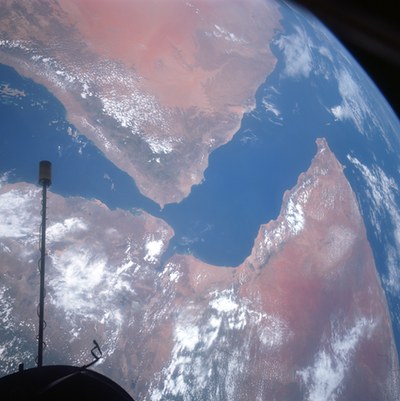Postcards from the edgeby Andre Bormanis
|
| We can certainly be sure that those photos have taught several generations how to see the Earth and its place in the Universe in a new way. |
Upon completing the Mercury archive, Robinson and his colleagues began working with the imagery taken from Gemini missions. On January 6, the Gemini archives came online, covering Gemini III through XII. A series of images from Gemini XI is particularly compelling. Docking with an Agena rocket in LEO, astronauts Pete Conrad and Dick Gordon were boosted higher than any humans prior to Apollo 8. A dramatic series of images shows Earth receding into the distance, its curvature becoming more and more distinct as the crew eventually reaches an apogee of 1,370 kilometers (850 miles). It’s a little sad to note that this remains the record altitude for a manned spacecraft orbiting the Earth.
The public archive has a slide show feature, and includes snippets of information on the various missions and their accomplishments. A three-year project is currently underway to digitize the Apollo mission images. Some Apollo images of the Moon from lunar orbit are already online.
ASU’s School of Earth and Space Exploration is an interdisciplinary program combining engineering and science research with the purpose of fostering a “Corps of Explorers” to expand human horizons in the 21st century. The work done by explorers in past centuries is also being recovered and processed for the digital age.
The New York Public Library (NYPL) has a growing digital archive, and recently posted scans of astronomical illustrations from the 19th century. Drawn by Étienne Léopold Trouvelot, who joined Harvard College Observatory in the 1870’s, some of the images included in the NYPL are a little too stylized to be considered accurate scientific documents, but during his career Trouvelot completed some 7,000 illustrations, with the goal of rendering “the celestial phenomena as they appear to the trained eye and to an experienced draughtsman through the great modern telescopes.” Astronomical photography soon displaced draftsmanship at the telescope eyepiece, but a number of amateur astronomers still employ the art of drawing to sharpen their observing skills, and to record details too fine or transient to be easily captured by cameras; many of their observations and drawings have scientific value as well.
Known mostly for her photographs of Depression-era America, Dorothea Lange lived to see the early Gemini flights, passing away in October, 1965. She was in ill health then, and I’ve found no written record of what she thought about the magnificent photos that astronauts were taking from space. But we can certainly be sure that those photos have taught several generations how to see the Earth and its place in the Universe in a new way. Thanks to digital archivists like Professor Robinson, they will continue to teach and inspire for generations to come.
